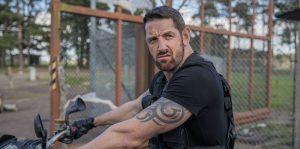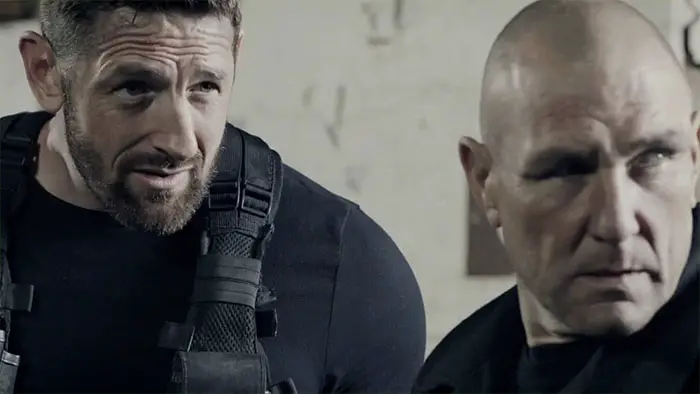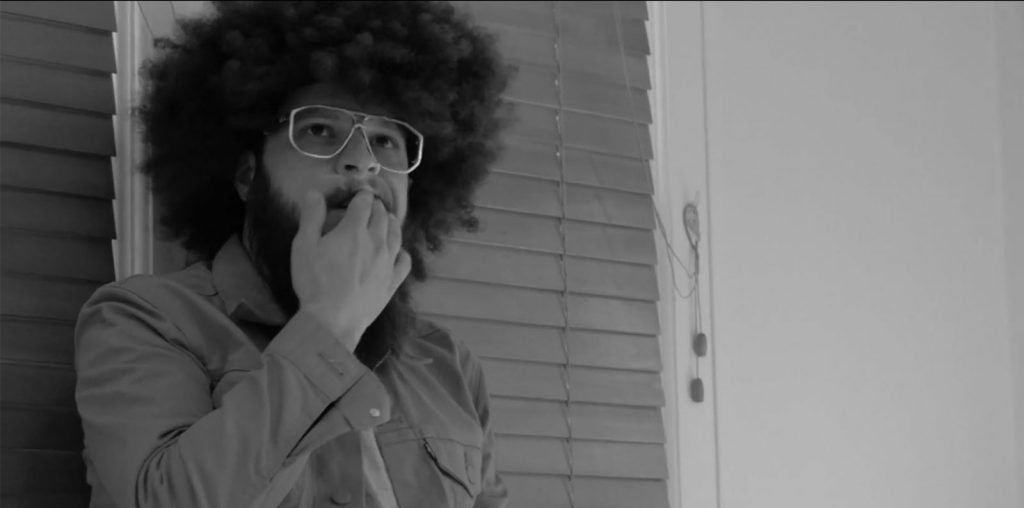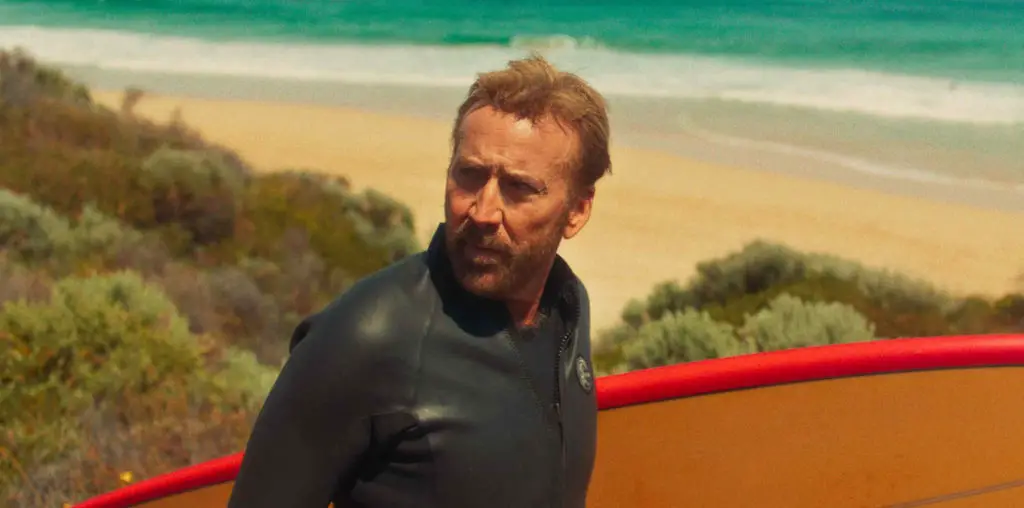
What is it like working with Ross? You just met him in a parking lot, and now you’re working on a film with him, for a second time.
Yeah, Ross is great. He and I are completely different. He loves comic books. He’s a complete film obsessive. He hates sports. I hate comic books. I’m not a film obsessive. And I love all sports. We’re completely different in that sense, but we clicked immediately. He’s a bit of a quirky character. I think most people who know me would say I’m a little odd too, which is kind of normal if you’re in the pro wrestling world. You have to be a little wild to be there. But we clicked immediately. We regularly speak when we’re not filming. We’re constantly texting. If he’s in LA, we’ll always go hang out. And if I’m in London, we’ll always go hang out together. We have a great relationship.
I’ve worked with directors and writers in various forms of entertainment, where their vision has to be stuck to completely. “Okay, here’s your path as a performer, you stick to this path, do not step one toe outside of this path.” Ross is humble enough as a director and writer to understand that to get the best out of the talent, they have to buy into the story and their characters. “Hey, this part of this scene where you want me to do this, Ross isn’t going to work well. Here’s why. Here’s how I think it should be done.” And there might be even dialogue that, “Hey, this isn’t coming naturally to me to say this. I know this is what you want to present to me. It doesn’t work. Here’s why.” Ross is always very attentive to that. I like that ability to kind of mold things with him. And his lack of ego in that regard. So yeah, he’s great to work with.
I would imagine you had much more influence on the development of the sequel then you did obviously with the first one.
Yeah, I’d say so. I mean, Ross sent me the script probably about three months before we started filming, and I went through it, and there were immediately certain things that I suggested to him about tweaking. “Hey, this doesn’t work for me here, how about this?” I certainly had a bit more opportunity to manipulate the script slightly with the second one. Like I say, it’s 99.9% Ross Boyask. I had the ability, especially as an executive producer on this one, to sprinkle a bit of my dust in little areas here with regards to the character of John and what I thought would and wouldn’t work.
Ross was great. The producers, John Adams and Diane Shorthouse, again were fantastic. They worked with me before, and they understand my perspective. They know anything I’m pitching to them or suggesting is not coming from a place of ego. It’s only because we’re all trying to make the film the best possible and make it as successful as possible. We’re all in this together. If it does well, we all do well. If it does poorly, then that is on us as well. So we all have a lot of respect for each other on that front.
One of the main differences between the two films is in the first film, it’s you against the bad guy. And in this one, it’s you and your team against a team of bad guys. Then there’s this crossing of lines between the cat and mouse. Can you speak to being part of a bigger picture here versus the first one
So, the first film, as you mentioned, John Gold is very much a solo man taking on a team of 10 or 12 bad guys on his own. He’s kind of a one-man killing machine. The film is very dark, and he’s very reflective. He doesn’t trust anyone and doesn’t want to speak to anyone. He’s kind of been living entirely on his own with no family or friends or anything for a few years at this point.
I love that film. I love the darkness, the grittiness of it. One of the limitations as an actor is when you’re in that kind of role you have very little, you can bounce on. You kind of get into this machine-like mode of head down, beat everyone up, kill, show very little emotion. Why I loved the second one is because of John’s increased interactions with the other performers. There are two characters, Shapiro and Lynch, who are kind of like squabbling children around me, who are part of my team. There are also interactions with Katrina Durden. We have this kind of history because I was with her father when he was killed. She’s upset about that, and I have to show more of a human side.

“I’m used to the instant adrenaline, instant gratification, the improv style of professional wrestling.”
As an actor in this film, it allowed me to open up a little more, yet still be this badass killing machine. I’m also allowed to explore my abilities to portray a more human side. And even add a little humor here and there, to bounce off other humans. So very excited to be able to do that, and very fortunate that in my early goings in this career, I’m getting this opportunity to explore a character arc over multiple films. So yeah, very happy.
Can you speak to the start-and-stop style of shooting in film versus the continuous action in the ring? Do you prefer one over the other?
There was definitely a transition period for me being a professional wrestler for 15 years and having over a thousand matches. I’m used to the instant adrenaline, instant gratification, the improv style of professional wrestling. You might be wrestling for 20 minutes straight, and the exhaustion that entails and coping with that. Then add 10,000 screaming fans along with being beamed live around the world to millions of TV sets. There are no retakes. We have to get it right the first time. Now I’m transitioning from the ring to this more cold, calm set of precision. “Hey, we didn’t get that. We need to shoot that exact thing again. And we’re only doing three or four punches as opposed to the entire fight scene.” It took me a long time to transition there and discover techniques of getting my adrenaline, emotions, and anger where it needs to be to portray an accurate fight scene.
I’m probably the worst guy on set to be around when we’re doing the fight scenes. I know I’m grumpy and angry, I’m short with people, and I usually have to apologize the next day. That’s just me getting into that mind frame, where I’m here to fight. Then they have to maintain that level of adrenaline for the scene. Some people handle it differently. That’s my way of handling it. I’m kind of a grumpy dark person on those days. That’s all to portray this fight scene well and be angry and staying in that mode and not clicking in and out.
Do they use multi-camera, or is it all getting coverage? Because I would imagine just the setups alone can be quite grating on keeping yourself in that emotional state of action.
They do a bit of both. They usually have two cameras shooting everything, but again, we have to have resets and retakes. “Okay. That punch wasn’t quite hitting.” And another issue we have too is I think there are 19 fights in this film. So the fight coordinators were stretched so thinly on it. We have very little rehearsal time in each location. Typically, it’s a lot of figuring out, “Okay, we’re filming this day. We had that quick rehearsal in June somewhere, now let’s get to set and start filming.” It doesn’t actually look how we planned it out in the gym once on the set. “Okay, that plan’s not going to work.” There’s a lot of figuring it out as we go along. I think it bonds the team together when we’re under that kind of pressure. Because we know we’re under time constraints here that anything we don’t get today, we’re never going to get. So get it now, let’s do it well. Let’s focus. And that keeps you in the zone.


